The Acropolis of Athens Old Museum
IntroductionThe Museum existing until lately on the Acropolis rock was considered among the most important ones in the world and definitely the most important one as far as the History of European Art is concerned. It was built on the Acropolis Hill in 1874, in such a way that it would not aesthetically interfere with the Temples, nor be visible from anywhere within the city of Athens.
The excavations that followed, toward the end of the 19th century, unearthed a wealth of finds which were impossible to exhibit in the limited space of the Museum. Thus, the inscriptions, bronzes, clay objects, and a variety of other items were kept in the National Archaeological Museum, where they were originally taken for conservation. The situation was aggravated after all the marble pieces were removed from the Parthenon Friezes (that is, what was left over after Elgin's plunder) and were put in the museum, together with the Caryatids (the marble statues of the women supporting the roof of the south porch of the Erechtheion), all of which were removed to be kept in an air-tight window containing nitrogen, so as to stop air pollution from deteriorating the marble surfaces.
The collections of the museum included:
Sculptural offerings of the Archaic period
Pediments of temples dated to the Archaic period
Archaic Horsemen
Sculptures of the "Severe" style
Pediments and metopes from the Parthenon
The Parthenon frieze
The Erechtheion frieze
Parapets of the Athena Nike temple
Frieze of the Athena Nike temple
The Caryatids
Clay figurines and vases from the sanctuary of the Nymphs.
Everyone was eagerly anticipating the completion of the new Acropolis Museum, for the total wealth of finds related to the Acropolis and the Parthenon to finally be exhibited in the best possible way (combining location, lighting, space, air filtering and thematic consistency), and thus deprive the descendants of Lord Elgin of all plausible excuses to insist that the Parthenon Marbles continue to be kept separated from the rest of their like and the Parthenon remain in its mutilated state.
During 2008, the exhibits of this Museun were transferred to the New Museum, the erection of which was completed. Three huge cranes were used to carry all the heavy marble statues and exhibits, a total of some 4,500 artifacts from the old, cramped Acropolis museum, a task that was the biggest airlift of antiquities in Greek history. It was the first time the artifacts — some of which are considered among the most important works of antiquity — were moved from the very Acropolis Rock. This transfer was completed in the end of spring but putting up the exhibits in their right place would take a lot longer.
We thought that the present Album would become useless after the New Museum's inauguration. Nevertheless, the decision of the museum authorities to prohibit taking photographs of the exhibits in their new surrounding created more problems than the ones it was supposed to solve. We admit that the decision was well meant, but, with all due respect, we would like to point out that times have changed; we are afraid that whatever is not shown online cannot achieve the level of promotion that it may be worthy of. We managed, though, to get a number of photos of the exhibits, as the decision was taken a couple of weeks after the museum's inauguration. We are working on them and will do our best to put them up as soon as possible. But, in our effort to best present the exhibits, we are sorry to have to use some of the photos taken at the Old Acropolis Museum. Until the New Acropolis Museum album is online, please enjoy the marvellous artifacts at their old "home".
(Photos: Michael Tziotis)
Select Page of the Album:
Click on any of the pictures to enlarge.
Gallery VArchaic dedications of the last quarter of the 6th century BC, the Gigantomachy pediment and the Kore of Antenor.
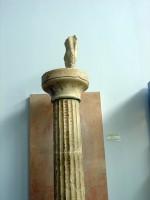
Akr 6506. Votive Column
Inscribed votive column made of island marble, with the signatures of the sculptor Pythis and the dedicator Epiteles. It is surmounted by a capital with painted meander and palmettes. On its top part of a statue of Athena has been preserved. The hole for fastening Athena’s spear, visible in the marble surface, makes us certain of the identity of the statue. Around 510 B.C. |
|
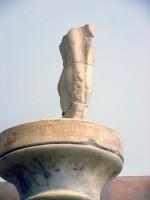
Akr 6506. Votive Column with Part of a Statue of Athena |
|
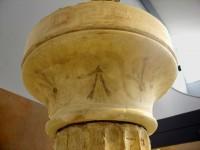
Akr 6506. Votive Column (Detail) |
|
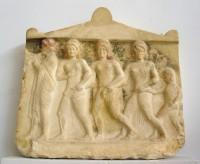
Akr 702. The Three Graces Relief
Three women dance with mincing steps, holding each other by wrist, the last one with a small boy. The man in front, playing a double flute, keeps up the rhythm of the dance. This charming relief cannot be interpreted with certainty. Most probably Nymphs or Graces are represented in their shrine where the relief was perhaps dedicated. Beginning of the 5th century B.C. |
|
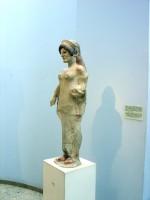
Akr 683. “Kore with dove”
The peculiarities of this figure, such as the disproportionately large head, the unnatural folds of the garment and the red pointed shoes, have led to the view that this piece may be the work of a Peloponnesian sculptor. The Kore has been associated with a base found on the Acropolis which carries the names of two dedicators, Lysias and Euarchis. End of 6th c. B.C. |
|
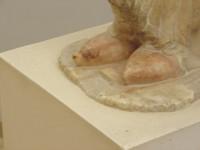
Akr 683. “Kore with dove” (Detail) |
|
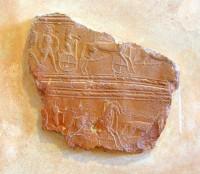
Akr 68. Fragments of relief pithoi
Fragments of relief pithoi made of red Attic clay. The representations, impressed by means of seals, are of two-horse chariots with charioteer and hoplite warrior; a procession of four-horse chariots with charioteer and a hoplite following on foot, and a dance of komasts. Dated in 650-550 B.C. |
|
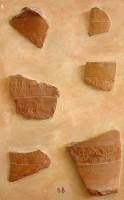
Akr 68. Fragments of relief pithoi |
|
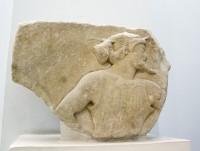
Akr 1343. Relief of a Male Figure
Relief from a frieze belonging to the architectural sculpture of the Old Temple of Athena. The male figure is shown with the body frontally and the head in profile, with a typically pointed beard. He wears a crinkly chiton and on his head he wears a petassos (a hat with a brim). This figure is customarily identified as Hermes, since it recalls depictions in vase painting of the time. The relief is delicately carved and dates to the last quarter of the sixth century B.C. |
|
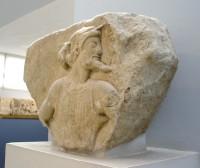
Akr 1343. Relief of a Male Figure |
|
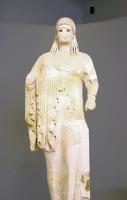
Akr 681. The Antenor Kore
Statue of a Kore of supernatural size, made of Parian marble. She is wearing chiton and himation, and a diadem with painted meander and inlaid bronze ornaments on her hair. Her eyes were inlaid of rock crystal. The statue is a work of Attic art about 520 B.C. and has been associated to the inscribed capital, exhibited near-by. According to the inscription, the potter Nearchos dedicated the statue as first-fruits and the sculptor Antenor made it. |
|
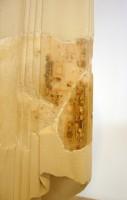
Akr 681. The Antenor Kore, Detail |
|
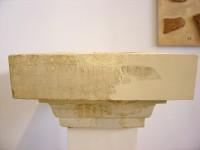
Akr 681. The Antenor Kore Base With the Inscription |
|
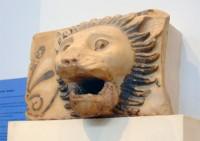
Akr 69. Lion Head Waterspout
Marble lion head waterspout from the “sime” of the old Temple of Athena, just south of the Erechtheion. The lion head, its savage expression strikingly rendered, is vividly painted on the mane, jaws and eyes and framed by a painted palmette. Fragments of a second lion head and two ram heads from the four corners of the temple “sime” are preserved. Last quarter of 6th century B.C. |
|
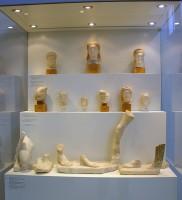
Window in Gallery V |
|
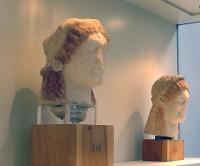
Akr 661+651: Top window-shelf
Akr 661. Helmeted head of Athena, made of Pentelic marble, around 510 BC. Akr 651. Head of a Kore of island marble, around 490 BC. |
|
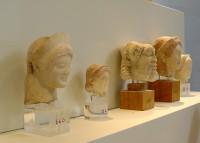
The whole of the middle window shelf in Gallery V, with the sculpted figures in profile |
|
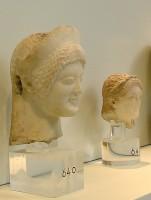
Akr 640+641. Heads of small Korai of Island marble; end of 6th century-beginning of 5th century BC. |
|
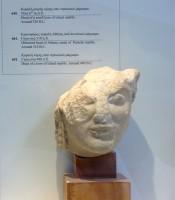
Akr 658. Head of Athena of Island marble; late 6th century BC. |
|
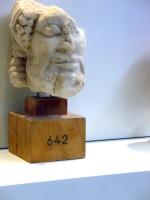
Akr 642. Head of Hermes
Head of Hermes from a herm. Around 510 B.C. |
|
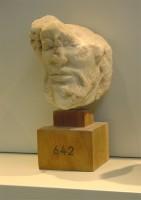
Akr 642. Head of Hermes
Head of Hermes from a herm. Around 510 B.C. |
|
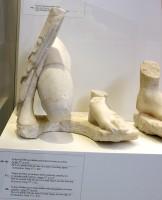
Akr 160+161. Part of a plinth with the feet of a male crouching figure in himation. Early 5th century B.C. |
|
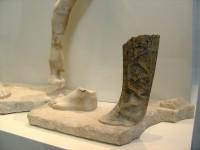
Akr 168. Part of a plinth with the feet of a male figure and the edge of his himation. Early 5th century B.C.
In the background part of Akr 571 with the front leg of a horse. Early 5th century B.C. |
|
|
Select Page of the Album:
|
|



